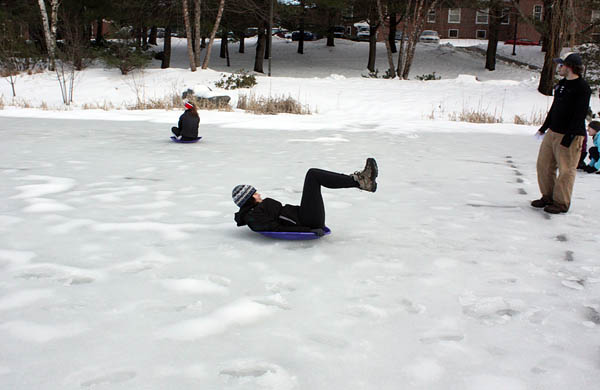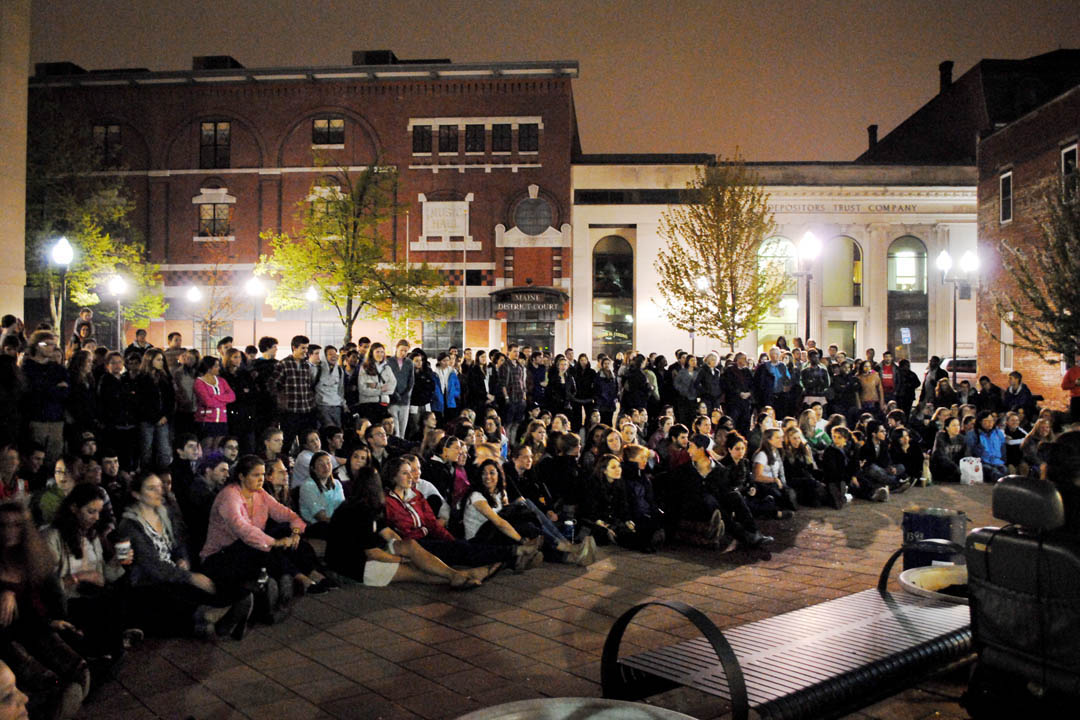
Inaugural Winter Throwdown leaves competitors curled, stumped, but happy
Marching toward a freshly painted Lake Andrews curling court in a parade of neon-, flower- and cheetah-patterned Spandex, competitors in the first annual Intercollegiate Winter Throwdown came brandishing team mascots, notably the superb white-bearded wizard gnome of the University of Maine at Farmington.
The teams were greeted at the Puddle by the games’ three judges, who issued succinct guidelines for the third event, Human Curling. Blocking and inter-team strategizing allowed; butt-scooching forbidden! As judges, contestants and spectators watched, the teams launched their living, breathing projectiles on green and purple discs toward a spray-painted black target.
Teams from Williams, Wesleyan, Tufts, UMF and Bates faced off in the initial heats. Following several overthrows, a more refined level of technique emerged that led Williams and the two Bates teams to an ultimate curling battle. In the end, team Lamesauce — Sam Prawer ’13 and first-years Sean Murphy, Erick MacLean and Nate Tower — narrowly beat Williams for the gold.
Produced by the Bates Outing Club, the Jan. 27-29 Throwdown was inspired by a now-defunct winter competition between Bates and close rivals Colby and Bowdoin. The resurrection was the brainchild of Matt Baker-White ’13, who thought hosting a winter event “would be a fun undertaking for the Outing Club, and a great way to get to know other outing clubs and bond with them over a shared passion.”
In addition to Human Curling, the Throwdown featured a cross-campus scavenger hunt whose to-dos included “planking” around campus, a human pyramid atop Mount David and pictures with the Outing Club’s current and previous presidents, Colin Barry ’12 and Kellen MacFadyen ’12, respectively.
The action-packed Throwdown schedule also included a sledding relay race and a Whisperlite campstove cooking contest at the BOC lean-to, in Greene, for Sunday breakfast. Both contests yielded impressive results. For instance, one team in the relay race made good use of a surfboard against the more typical toboggans and discs. And Tufts’ goat-cheese crepes took the breakfast crown, but Williams’ team also deserves an honorable mention for their maple beer-soaked crisp bacon.
Throwdown organizers made sure to introduce the visitors to the classic BOC game of Stump, featuring it as a major event. The game, played in the BOC E-Room, in the basement of Hathorn Hall, is played with participants circled around and two nails set in a large tree stump. The object is to toss a hammer up so that it spins, catch it again and swiftly hammer the competition’s nails fully into the stump. The last player with a protruding nail wins.
Throwdown judge Saebyul Choe ’14, a BOC Stump standout, was more than happy to advise Bates’ guests on technique. “Tossing the hammer clockwise gives a lot more leverage when coming down,” she explained to a struggling UMF competitor.
Despite the excitements of Stump and the weekend’s other games, competitors agreed that Human Curling was the most fun. Co-organizer and judge Torri Zapack ’13, however, wasn’t entirely convinced. “Crepes! On a Whisperlite! And they had goat cheese,” she exclaimed.
Williams received the first-ever Throwdown Winner’s Cup during the closing awards ceremony. Bates Tunesquad, Tufts, Lamesauce and the teams from Wesleyan and UMF ranked second through fifth, respectively. The BOC anticipates a long life for the games: the Cup, handcrafted from E-Room cross-country skis, has space for the names of game champions through 2024!
Baker-White and Zapack were extremely pleased with the inaugural event. He and Zapack learned a lot from “the real-life event planning experience,” Baker-White said, noting that even after months of preparations, “it still felt like we were flying by the seat of our pants for much of the weekend!”
“One of the best things about the BOC is its ability to come up with anything — like conceive of an event — and go for it. It’s a huge advantage of being completely student-run.”
— By Elana Leopold ’12





